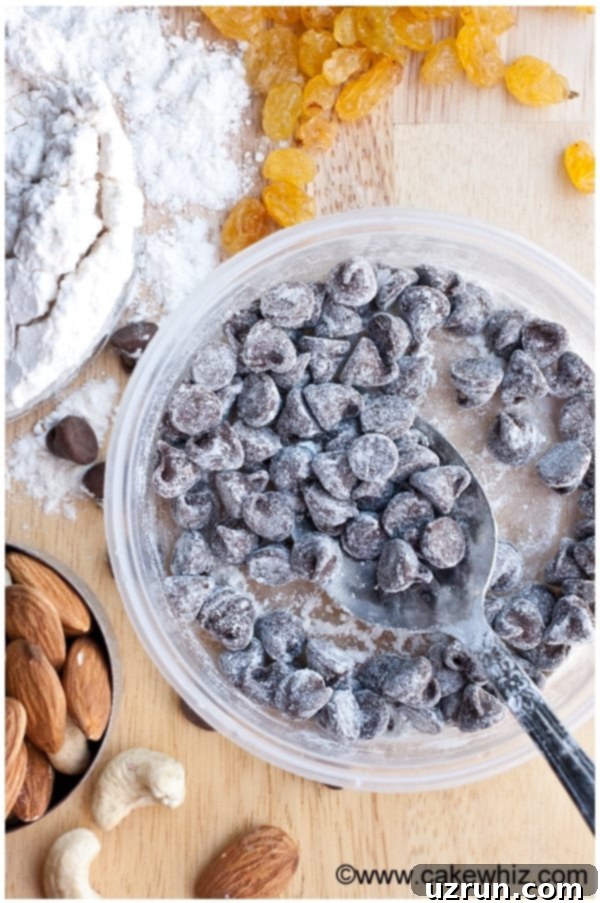The Secret to Perfectly Distributed Add-Ins: How to Prevent Chocolate Chips from Sinking with Flour
There’s nothing quite like biting into a warm, freshly baked cake or muffin, only to find all the delicious chocolate chips (or nuts, or fruit pieces!) have congregated sadly at the very bottom. It’s a common baking frustration, one that many home bakers experience. But what if there was a simple, almost magical trick to ensure every bite delivers that perfect burst of flavor? Good news – there is! And it involves just one basic pantry staple: flour. This ingenious method works wonders not only for chocolate chips but also for other delightful add-ins like chopped nuts, diced apples, and sweet pears, ensuring they stay suspended beautifully throughout your baked goods.
I still vividly remember my own first encounter with this baking dilemma. I was around twelve or thirteen, brimming with excitement as I decided to bake a chocolate chip cake for my Mom’s birthday entirely by myself. Every step, from creaming the butter and sugar to folding in the chocolate chips, felt like a grand culinary adventure. I imagined her face lighting up as she saw the perfectly studded cake, a testament to my burgeoning baking skills. However, my excitement quickly turned to a slight pang of disappointment when she cut the first slice. There, at the very bottom, lay almost every single chocolate chip, forming a dense, unappetizing layer. Despite my dismay, my Mom, being the wonderful woman she is, didn’t even bat an eye. She was simply overjoyed and incredibly proud of my effort, showering me with hugs and praise.
I tried to explain that I must have somehow “messed up” the recipe, convinced that my chocolate chips were supposed to be evenly dispersed. She just smiled, gave me another big hug, and gently told me that we could bake the cake together again soon. She promised to show me a neat little trick, a simple solution that would prevent chocolate chips from ever sinking to the bottom of our cakes again. That memory, and the lesson she taught me, has stayed with me ever since, transforming my approach to baking. And today, I’m thrilled to share that timeless wisdom with all of you, so you can achieve perfectly balanced bakes every time.
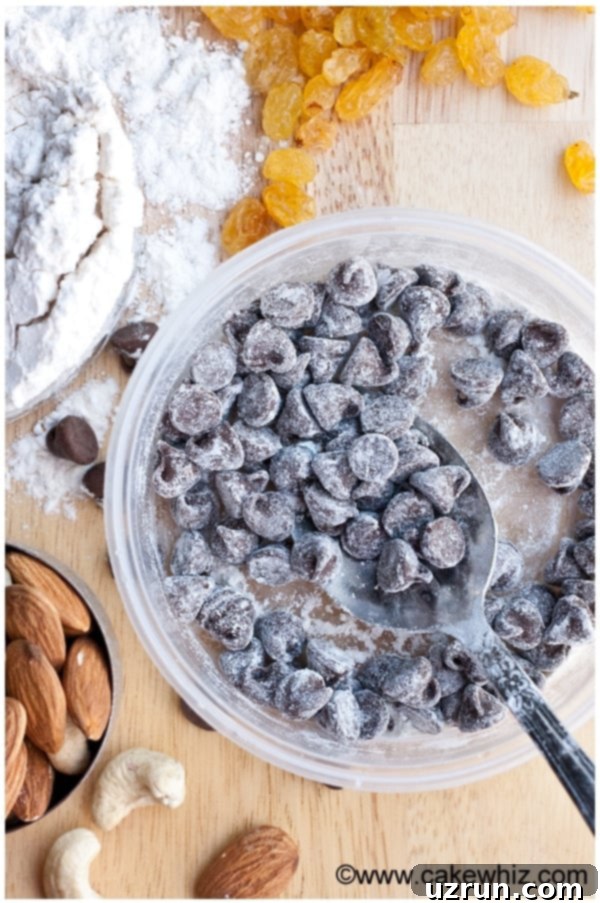
The Science Behind the Sinking Sensation: Why Do Add-Ins Take a Dive?
Before we dive into the solution, it’s helpful to understand why this sinking phenomenon occurs in the first place. The primary culprit is simple physics: density and gravity. Most cake and muffin batters, especially when liquid, have a lower density than heavier add-ins like chocolate chips, nuts, or fruit pieces. As the batter sits before baking, or as it begins to warm in the oven, these denser ingredients are naturally pulled downwards by gravity, settling at the bottom of the pan. This is particularly true for thinner batters or when ingredients are added too early and left to sit for a long time.
Another factor can be the texture of the add-ins themselves. Smooth, hard items like chocolate chips offer less resistance to the batter, allowing them to slide through easily. This is where our simple flour trick comes into play, creating a subtle barrier and increasing friction to counteract gravity’s pull.
The Genius Flour Trick: A Simple Solution for Even Distribution
A few weeks after my birthday cake baking attempt, my Mom and I indeed made that same chocolate chip cake. This time, however, she introduced me to her secret weapon. Before adding the chocolate chips to the batter, she took a small bowl, added a modest amount of flour, and then tossed the chocolate chips in. With a few gentle stirs, they became lightly coated with a fine dusting of flour. She then carefully folded these coated chips into the cake batter. I distinctly remember thinking, “Could something so incredibly easy really make a difference?”
To my absolute delight and amazement, it worked like a charm! When we cut into that second chocolate chip cake, the chips were no longer banished to the bottom. Instead, they were beautifully scattered throughout the cake, gracing every single slice. It was a revelation, a testament to how simple yet effective baking tips can truly transform your results.
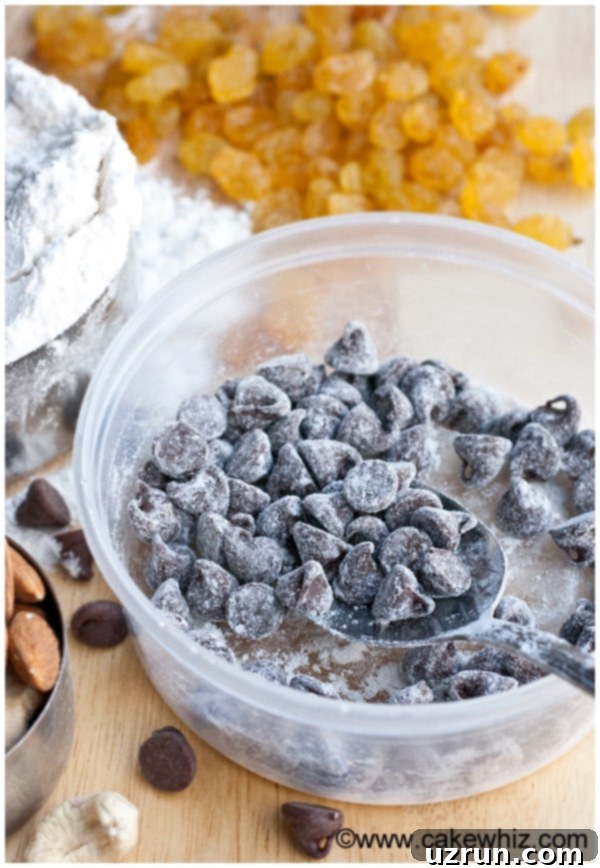
How the Flour Coating Works Its Magic
The science behind this simple flour trick is quite brilliant. By coating your add-ins, whether they are chocolate chips, nuts, or fruit, you are essentially creating a thin layer that adheres to their surface. This layer of flour achieves two key things:
- **Increases Surface Area & Friction:** The flour coating slightly increases the surface area of your add-ins and creates a rougher texture. This increased surface area and friction help the add-ins “grip” the batter, making it harder for them to slide down through the liquid.
- **Reduces Density Differential:** The flour absorbs a tiny bit of moisture from the batter and creates a sort of suspension. It subtly lightens the effective density of the add-in by making it less ‘slick’ against the batter, allowing it to be more easily held in place by the batter’s viscosity.
This combined effect is usually enough to overcome gravity’s pull, keeping your delicious additions evenly suspended as the cake bakes and the batter sets.
Extending the Flour Trick Beyond Chocolate Chips: Versatility for Various Add-Ins
The beauty of this technique is its versatility. This invaluable tip isn’t just for chocolate chips; it’s applicable to almost any “heavy” add-in you wish to incorporate into your cakes, muffins, quick breads, or even pancake batter. Consider it your go-to method for ensuring an even distribution every single time.
Nuts: Chop First, Then Coat
If you’re planning to incorporate nuts into your cake batter, there’s an additional, crucial step to consider: chopping them. Whole nuts, especially larger varieties like pecans or walnuts, tend to be quite heavy. Even with a flour coating, their sheer weight can still cause them to sink. Chopping them into smaller, more manageable pieces significantly reduces their individual weight, making them much easier for the flour coating and the batter to suspend. Once chopped, proceed with the flour coating as usual. I often place nuts in a Ziploc bag and give them a few good taps with a hammer or rolling pin to get them to the desired consistency. No need for fancy equipment!
Dried Fruits: Raisins, Cranberries, and More
Similar to chocolate chips, dried fruits like raisins, cranberries, cherries, or even chopped dates benefit immensely from this flour coating. They are naturally dense and can easily sink. A light dusting of flour helps them stay put, ensuring a juicy, fruity burst in every bite of your scone or fruitcake.
Fresh Fruits: Apples, Pears, and Berries
For fresh fruit pieces, like diced apples, pears, or even whole blueberries, the flour trick is equally effective, though you might need a tiny bit more flour. Fresh fruits contain more moisture, which can sometimes make the flour coating less effective if not applied generously enough. The flour acts as a barrier, preventing the fruit’s natural moisture from excessively thinning the batter around it, which could otherwise lead to sinking. Just be sure the fruit pieces are relatively dry on the surface before tossing them in flour for the best adhesion.
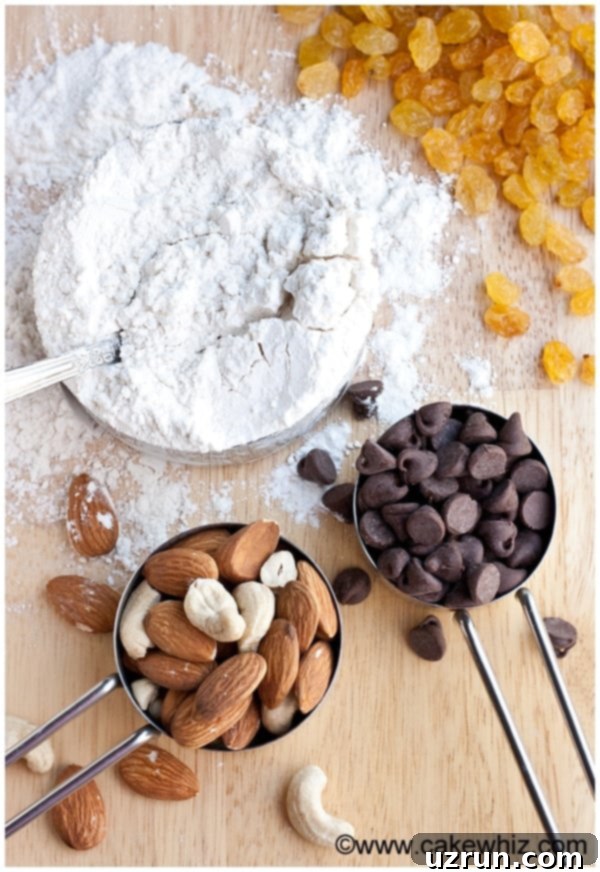
Troubleshooting and Common Mistakes
While the flour trick is incredibly effective, here are a few additional tips to ensure your add-ins stay perfectly suspended:
- **Don’t Over-Mix:** Once you’ve folded in your coated add-ins, avoid excessive mixing. Over-mixing can develop the gluten in your flour, leading to a tougher texture, and can also cause the add-ins to shed their flour coating and begin sinking again. Mix just until combined.
- **Batter Consistency Matters:** If your batter is very thin or runny, even a flour coating might not be enough to prevent some sinking, especially with extremely heavy additions. In such cases, ensure your recipe’s liquid-to-dry ingredient ratio is correct.
- **Temperature of Ingredients:** Ensure your add-ins (especially chocolate chips) are at room temperature. Cold chocolate chips can shock the batter and contribute to clumping or sinking.
- **The Right Amount of Flour:** A light dusting is all you need. You’re not trying to create a thick crust. Too much flour can sometimes alter the texture of your final baked good or leave powdery streaks. Just enough to create a thin, visible coat is perfect.
The Benefits of Evenly Distributed Add-Ins
Beyond simply avoiding the disappointment of finding all your goodies at the bottom, achieving an even distribution of add-ins offers several advantages:
- **Consistent Flavor:** Every single bite will contain the desired flavor and texture from your additions, creating a more enjoyable eating experience.
- **Appealing Presentation:** Cakes and muffins with evenly distributed chocolate chips or nuts simply look more professional and inviting.
- **Balanced Texture:** The varied textures contribute to a more dynamic and satisfying mouthfeel throughout the entire baked good.
More Baking Tips and Tricks
Baking is a delightful journey of learning and discovery. Mastering small techniques like this one can elevate your home baking significantly. If you’re eager to expand your baking knowledge even further, check out these other helpful guides:
- How to make homemade sprinkles
- How to make marshmallow fondant
- Homemade cake flour
Recipe: The Foolproof Flour Trick for Perfect Add-In Distribution
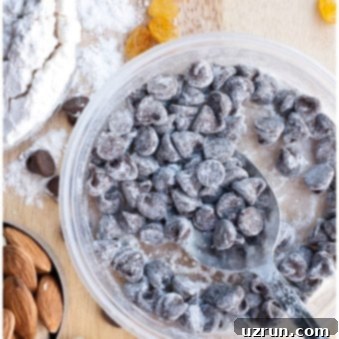
How To Stop Chocolate Chips From Sinking
Abeer Rizvi
Pin Recipe
Craving more baking secrets? Save This Recipe!
Enter your email and I’ll send this essential baking tip directly to your inbox. Plus, get fantastic new recipes from me every week to perfect your baking skills!
By submitting this form, you consent to receive emails from CakeWhiz
Ingredients
- 1-2 tablespoons All-Purpose Flour Adjust quantity based on the wetness of your add-ins (more for moist fruits, less for dry chips/nuts).
- 1 cup Your Choice of Add-ins e.g., chocolate chips, chopped nuts (ensure nuts are chopped for best results), dried fruits, or small fruit pieces like diced apples/pears.
Instructions
-
In a small bowl, combine your measured flour with your chosen add-ins (e.g., chocolate chips, chopped nuts, or fruit pieces). Ensure the add-ins are at room temperature.
-
Gently mix with a spoon or your hands until all the add-ins are lightly and evenly coated with flour. You want a thin, visible dusting, not a thick paste.
-
Carefully fold these flour-coated add-ins into your prepared cake, cupcake, or muffin batter. Mix just until they are evenly distributed throughout the batter. Avoid overmixing.
-
Pour the batter into your baking pan and bake according to your recipe’s instructions. That’s it! Enjoy perfectly suspended add-ins in every delicious bite.
Notes
– **Chopping Nuts:** Always chop nuts into smaller pieces before coating and adding them to the batter. Larger, heavier nuts are more prone to sinking even with a flour coating.
– **Gentle Folding:** Once the add-ins are coated, fold them into the batter just before baking. This minimizes the time they have to sink and prevents overmixing the batter.
Nutrition
An automated tool is used to calculate the nutritional information. As such, I cannot guarantee the accuracy of the nutritional information provided for any recipe on this site. Please note that these values are for the flour and add-ins only, not the entire baked good.
